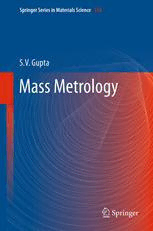
Mass Metrology PDF
Preview Mass Metrology
SpringerSeriesin materials science 155 SpringerSeriesin materials science Editors: R.Hull C.Jagadish R.M.Osgood,Jr. J.Parisi Z.Wang The Springer Series in Materials Science covers the complete spectrum of materials physics, includingfundamentalprinciples,physicalproperties,materialstheoryanddesign.Recognizing theincreasingimportanceofmaterialsscienceinfuturedevicetechnologies,thebooktitlesinthis seriesreflectthestate-of-the-artinunderstandingandcontrollingthestructureandproperties ofallimportantclassesofmaterials. PleaseviewavailabletitlesinSpringerSeriesinMaterialsScience onserieshomepagehttp://www.springer.com/series/856 S. V. Gupta Mass Metrology With 126 Figures 123 Dr. S. V. Gupta Sector-8, Rohini 269/B-5 110085 Delhi India [email protected] SeriesEditors: ProfessorRobertHull ProfessorJu¨rgenParisi UniversityofVirginia Universita¨tOldenburg,FachbereichPhysik Dept.ofMaterialsScienceandEngineering Abt.Energie-undHalbleiterforschung ThorntonHall Carl-von-Ossietzky-Straße9–11 Charlottesville,VA22903-2442,USA 26129Oldenburg,Germany ProfessorChennupatiJagadish Dr.ZhimingWang AustralianNationalUniversity UniversityofArkansas ResearchSchoolofPhysicsandEngineering DepartmentofPhysics J4-22,CarverBuilding 835W.DicknsonSt. CanberraACT0200,Australia Fayetteville,AR72701,USA ProfessorR.M.Osgood,Jr. MicroelectronicsScienceLaboratory DepartmentofElectricalEngineering ColumbiaUniversity SeeleyW.MuddBuilding NewYork,NY10027,USA SpringerSeriesinMaterialsScience ISSN0933-033X ISBN978-3-642-23411-8 e-ISBN978-3-642-23412-5 DOI10.1007/978-3-642-23412-5 SpringerHeidelbergDordrechtLondonNewYork LibraryofCongressControlNumber: 2012930378 ©Springer-VerlagBerlinHeidelberg2012 This work is subject to copyright. All rights are reserved, whether the whole or part of the material is concerned,specificallytherightsoftranslation,reprinting,reuseofillustrations,recitation,broadcasting, reproductiononmicrofilmorinanyotherway,andstorageindatabanks.Duplicationofthispublicationor partsthereofispermittedonlyundertheprovisionsoftheGermanCopyrightLawofSeptember9,1965,in itscurrentversion,andpermissionforusemustalwaysbeobtainedfromSpringer.Violationsareliableto prosecutionundertheGermanCopyrightLaw. Theuseofgeneraldescriptivenames,registerednames,trademarks,etc.inthispublicationdoesnotimply, evenintheabsenceofaspecificstatement,thatsuchnamesareexemptfromtherelevantprotectivelawsand regulationsandthereforefreeforgeneraluse. Printedonacid-freepaper SpringerispartofSpringerScience+BusinessMedia(www.springer.com) Dedicatedtomy wife,Mrs Prem Gupta Childrenand Grandchildren as Theyallinspiremeto livelonger • Preface FreshfromtheUniversityofAllahabadandjoiningNationalPhysicalLaboratoryin 1954,Ifoundmyselfinanaltogetherdifferentworld.Itappearedthatwhatwelearnt at MSc level was differentfrom what we need at NPL. Naturally I started asking manyquestionsas to why we are performingin a particularway. After prolonged discussion,Iusedtohearthefinalansweras“NPLUKisdoingitthisway”.There was hardly any detailed literature on mass measurement, except some notes from NPL UK and a Dictionary of Applied Physics, at that time I vow to myself to compilealltheavailableliteratureonMassMetrology.However,ittookmeanother 55 years to complete my dream. My conceptwas to give every available thing in theliteratureormyownexperienceaboutmassmetrologyintheformofabook.In theprocessIforgotwhatisrequiredinpresenttimesandnotnecessaryforpresent generation.For example I included great details and mathematicsabout weighing with a two-pan balance. My concept is that a very few books are available about massmeasurementso I tried to includea lotof thingswhichmightnotbeneeded inthecontemporarytime.Allsuchsuperfluousmaterialshavebeencurtailedonthe recommendationofthereviewerofthebook. Besides the routine chapters on unit of mass, mass measurement system in India;two-andsingle-panbalancesandtheirmaintenanceandtesting,Ihavetaken up the various transducers used for weighing and included their testing. I have provedthat maximumpermissible error requirementsare the same for digital and analoguebalances,andagreatdetailonenvironmentaleffectsonweightsfrombest material is given. The methods for air density determination have been given in detail. In the process, changed composition of argon in air discovered from the measurementofairdensityinsitucarriedoutwithsolidobjectsandthatcalculated from BIPM equation has been discussed. The methods of mass determination of different weights in a set in terms of the mass of head weight are described in detail with numerical examples. Optimisation of weighing designs and solution of normal equations are described. A new chapter on the detection of small mass differencestothe limitof zeptogram10(cid:2)21 g (massofa quarterofthegoldatom) hasbeenproduced.Fabricationanddetectionoffrequencyusing nano-technology are mentionedwith sufficientreferences. Details of micro-cantileversused for the vii viii Preface purposearegiven.Theapplicationsofmicro-cantileverinotherfieldsareoutlined. Themethodsofredefiningthekilogram,theunitofmass,intermsoffundamental constantshavebeendescribed.Thechapterisconcludedwiththepresentstatusand futureplantodefinethekilogram. Special attention has been paid to the need of Legal Metrology.Special topics suchasthemaintenanceandupkeepofstandardbalanceskeptatvariouslevelsand effectofgravityonelectronicbalanceshavebeendiscussed.Thelimitsofmovement of classes I to IV electronic balances in north–southdirection have been given in detailforpracticallyallsituations. I acknowledge the help of Dr R.S. Davis, Head of Mass Standards at BIPM. I will fail in my duty if I do not express my most sincere thanks to the reviewer of the book for his keen interest and suggestions. My thanks are also due to my daughterMrsReetaGupta,Scientist,NationalPhysicalLaboratory,forhersincere day-to-dayhelp.Iwishtorecordmyprofoundappreciationforthekeeninterestand strenuouseffortsputinbyDrHabil.ClausAscheron,theExecutiveEditorPhysics, formakingit possibleto bringthe manuscriptto the desiredleveland to Springer VerlagGmbH,Germany,andinbringingthisbooktolight. NewDelhi S.V.Gupta August2011 Contents 1 UnitofMassandStandardsofMass..................................... 1 1.1 ConceptsofMass................................................... 1 1.1.1 GravitationalMass ..................................... 2 1.1.2 InertialMass............................................ 2 1.1.3 EqualityofInertialandGravitationalMass........... 3 1.2 MassandWeightofaBody ........................................ 3 1.2.1 ConventionalMass ..................................... 4 1.2.2 Variation of the Weight of a Body onSurfaceofEarth..................................... 4 1.3 UnitofMass......................................................... 7 1.3.1 HistoryoftheUnitsofMetreandKilogram.......... 7 1.3.2 UnitofLength.......................................... 8 1.3.3 KilogramdeArchives.................................. 8 1.4 MetricConvention.................................................. 8 1.4.1 InternationalKilogram................................. 9 1.4.2 NationalPrototypesofKilogram...................... 11 1.4.3 NationalPrototypeKilogramandOther StandardsinIndia ...................................... 11 1.4.4 CalibrationofTransferStandardsofMass............ 12 1.5 HierarchyofMassStandards....................................... 12 1.5.1 Nomenclature........................................... 12 1.5.2 MeasurementChain.................................... 14 1.5.3 TrackingtheMassValuesofStandards ............... 14 1.5.4 PeriodofVerificationorCalibration................... 15 1.5.5 MaximumPermissibleErrors.......................... 15 1.6 TraceabilityofMeasurements...................................... 15 1.6.1 Traceability ............................................. 15 1.6.2 CIPMMRA............................................. 17 References.................................................................... 17 ix x Contents 2 Two-PanEqual-ArmBalances............................................ 19 2.1 Introduction......................................................... 19 2.2 BriefHistory ........................................................ 19 2.3 Other1-kgBalances ................................................ 20 2.3.1 Equal-ArmInterchangeablePan BalanceUK............................................. 20 2.3.2 EqualArmwithDoubleInterchangeable PanBalance............................................. 22 2.3.3 SubstitutionBalanceNPL-India....................... 22 2.3.4 ElectronicBalancewithAutomation atNPL-India............................................ 23 2.3.5 HydrostaticBalance.................................... 24 2.4 InstallationofaBalance............................................ 26 2.4.1 ProperEnvironmentalConditions forBalanceRoom ...................................... 26 2.4.2 RequirementsforLocationoftheBalance............ 26 2.5 EvaluationofMetrologicalDataforaBalance.................... 27 2.5.1 NeedforEvaluation.................................... 27 2.5.2 VisualExamination..................................... 29 2.5.3 Sensitivity............................................... 30 2.5.4 PeriodofSwingorTimePeriod....................... 32 2.5.5 AccuracyofRiderBar ................................. 33 2.5.6 Stability/Repeatability................................. 35 2.5.7 RepeatabilityofWeighing ............................. 35 2.5.8 EqualityofArmLengths............................... 36 2.5.9 CalculationofArmRatio,Repeatability ofSingleandDoubleWeighing ....................... 37 2.5.10 RequirementforArmRatio andRepeatabilityofWeighing......................... 39 2.5.11 TestforParallelismofKnifeEdges ................... 39 2.6 MethodsofWeighing............................................... 41 2.6.1 DirectWeighing........................................ 41 2.6.2 TranspositionWeighing................................ 41 2.6.3 SubstitutionWeighing.................................. 42 2.7 DoubleTranspositionandSubstitutionWeighing................. 42 2.7.1 DoubleTranspositionMethod......................... 42 2.7.2 DoubleTranspositionwithSimultaneous DeterminationofS.R................................... 43 2.7.3 DoubleSubstitution .................................... 45 2.7.4 Double Substitution Weighing with SimultaneousDeterminationofS.R. .................. 45 2.8 MaintenanceofStandardBalances ................................ 46 2.8.1 CategoryofBalances................................... 46 2.8.2 ReferenceBalances..................................... 46
